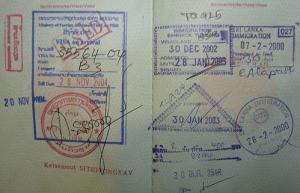Visas1 percent of visitors to U.S. over-stayed past 2015 exit dates
DHS said that about 1 percent of visitors who arrived in the country by air or sea remained in the country last year after they were supposed to leave. DHS release data on Tuesday which show that about 45 million of those visitors were due to leave at some point in the year ending 30 September, and that DHS could confirm that all but 416,500 had exited the country. Another 66,500 people stayed past their leave date, but later left the United States.

Visa overstays provide a small share of illegal immigrants // Source: Mattes via commons.wikimedia.org
DHS said that about 1 percent of visitors who arrived in the country by air or sea remained in the country last year after they were supposed to leave.
DHS release data on Tuesday which show that about 45 million of those visitors were due to leave at some point in the year ending 30 September, and that DHS could confirm that all but 416,500 had exited the country. Another 66,500 people stayed past their leave date, but later left the United States.
The over-stay visitors include both business and pleasure travelers whose visa was either given for a specific period, or who came to the United States from a country whose citizens do need to obtain a visa to enter the United States, but are rather authorized to stay in the country for a certain amount of time.
DHS says that about 85 percent of all over-stay visitors belong in these two categories.
VOA reports that rates of over-stays were lowest among the thirty-eight countries which are part of the Visa Waiver program. Citizens of these thirty-eight countries account for 0.65 percent of over-stays. No country had a rate over 2.5 percent.
The other 154 countries – that is, countries which are not members of the Visa Waiver program – collectively account for an over-stay rate of 1.6 percent, and ten of them exceeded 10 percent.
The biggest offenders were countries that had relatively few visitors to the United States, while those with larger visitor populations in the hundreds of thousands mostly had rates under 2 percent.
DHS said it had identified two major holes in the data which prevent a more comprehensive analysis of how many people overstay their visas in the United States.
The first is the lack of data regarding those who enter the country by land from Canada and Mexico. There were more than 200 million visitors that way last year, and DHS says it is working on ways to include them in future data sets.
The other hole is in the types of visas included. The data does hit what are by far the largest categories, but DHS says it wants to include more, specifically the F, M, and J visas given to visiting students and teachers.
VOA notes that Congress enacted new rules in December tightening the waiver program. Anyone with citizenship from Iran, Iraq, Syria, or Sudan, or those who traveled to one of those countries in the past five years, is not eligible for a waiver and must get a visa to enter the United States.
